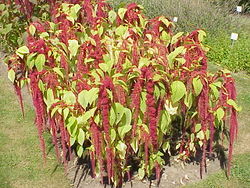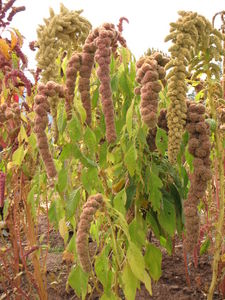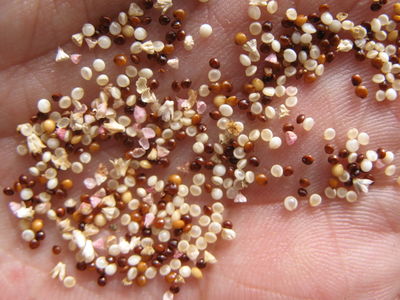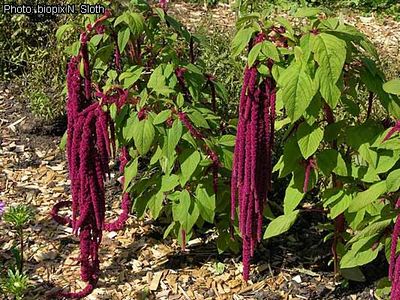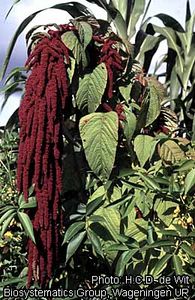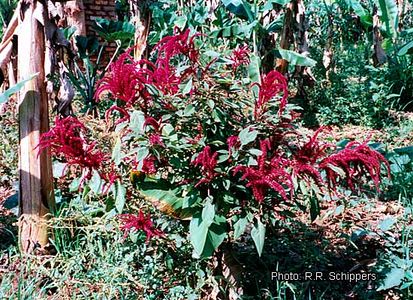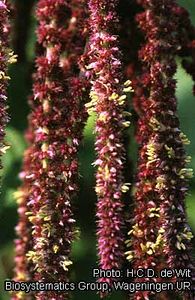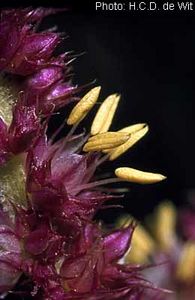Amaranthus caudatus
De PlantUse Français
Amaranthus caudatus L.
| Ordre | Caryophyllales |
|---|---|
| Famille | Amaranthaceae |
| Genre | Amaranthus |
2n = 32, 34
Origine : Andes
sauvage ou cultivé
| Français | amarante queue de renard |
|---|---|
| Anglais | ' |
Résumé des usages
- graines comestibles
- graines transformées en bière
- ornemental
- légume-feuille
Sommaire
Description
kiwicha (Crops for the Future)
graines (Crops for the Future)
Noms populaires
pseudo-céréale
| français | amarante-grain, blé des Incas |
| anglais | grain amaranth, Inca wheat, jataco |
| espagnol | bledo ; quinoa del valle, trigo inca (Argentine) |
| portugais | amaranto de cauda |
| quechua | kiwicha, quihuicha, coimi, millmi, achita, inca-pachaqui |
| hindi | रामदाना - ramdana (Mansfeld) |
légume-feuille
| français | brède malabar |
| anglais | African spinach, Indian spinach |
| portugais | bredo |
| swahili | mchicha |
| Indonésie | bayam ekor kucing |
| Malaysia | bayam selaseh (PROSEA) |
| Thaïlande | phakkhom-baidaeng (Bangkok) (PROSEA) |
| Vietnam | rau dền duôi (PROSEA) |
ornementale
| français | queue de renard, discipline de religieux |
| anglais | love-lies-bleeding, red-hot cattail, foxtail |
| allemand | Fuchsschwanz |
| néerlandais | kattestaart |
| italien | disciplina religiosa |
| portugais | cauda de raposa, moncos de peru |
- Voir les noms de la Flore populaire d'Eugène Rolland
Classification
Amaranthus caudatus L. (1753)
synonymes :
- Amaranthus mantegazzianus Passerini (1865)
- Amaranthus edulis Spegazzini (1917)
Cultivars
Histoire
Usages
Only cultivated as grain crop or ornamental, subdivided into the following two subspecies, earlier mostly described as true species:
- subsp. caudatus : As a grain crop cultivated in the Andes from Ecuador to NW Argentina, especially in Peru and Bolivia, in the valleys and marginal ranges of the Himalaya from Kashmir to Bhutan, also in other parts of India, especially in the South, in W China, SE Asia and in Ethiopia. As an ornamental however cultivated in many countries of the world. The seeds, rich in protein, are used in various ways, they are parched and cooked to gruel, milled for flour, popped and mixed with honey for special confections, prepared for beer (Peru, Ethiopia). The species originated in South America (pre-Columbian remnants, early records by the Spanish conquistadores); it was introduced to Europe already in the 16th cent.; A. quitensis may be the ancestral species; hybrids between the cultigen and this species have been reported. After serious dwindling of the cultivation until the middle of the 20th cent. new impetus led to modern breeding programs, e.g. in India and Peru (several recent cultivars), many cultivation experiments etc.
- subsp. mantegazzianus : Cultivated as a grain crop in the valleys of the Andes in NW Argentina, also mostly on small plots. Usage as in subsp. caudatus, traditional endemic crop.
Mansfeld.
Références
- Chauvet, Michel, 2018. Encyclopédie des plantes alimentaires. Paris, Belin. 880 p. (p. 23)
- Dambourney, Louis-Alexandre, 1786. Recueil de procédés et d'expériences sur les teintures solides que nos végétaux indigènes communiquent aux laines & aux lainages. Paris, De l'imprimerie de Ph.-D. Pierres, premier imprimeur ordinaire du roi. 407 p. Voir sur Pl@ntUse
Liens
- BHL
- FAO Ecocrop
- Feedipedia
- GRIN
- IPNI
- Lost Crops of the Incas (1989)
- Mansfeld
- Moerman, Native American Ethnobotany
- Multilingual Plant Name Database
- NewCrop Purdue
- Plant List
- Plants for a future
- Plants of the World Online
- PROSEA sur Pl@ntUse
- PROTA sur Pl@ntUse
- TAXREF
- Tela Botanica
- Useful Tropical Plants Database
- Wikipédia
- World Flora Online
